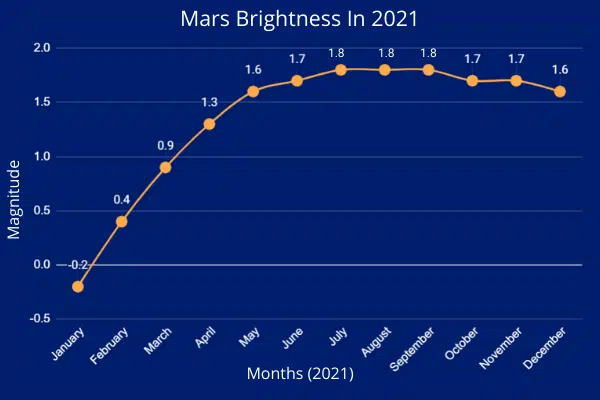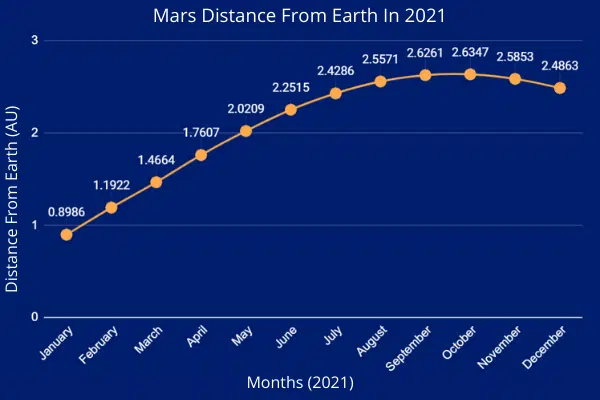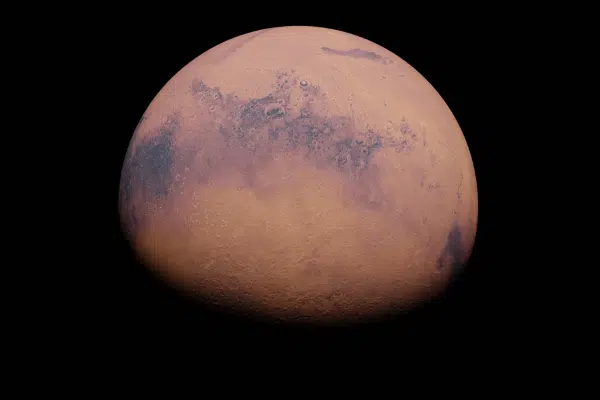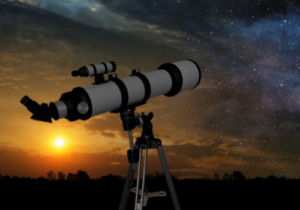How To See Mars Through A Telescope (Easy Steps)
Disclosure: This post contains affiliate links and I may earn a small commission (at no extra cost to you) if you click through and make a purchase. Thanks in advance – I really appreciate it!
I remember seeing Mars for the first time through my 8” reflector when I was just a teenager, it was a breathtaking experience. The planet Mars can be one of the most interesting planets to observe, but also one of the most difficult.
Key Takeaways:
How to see Mars through a telescope?
A telescope with an aperture size of 5” to 8” is the recommended minimum to observe Mars in the night sky. The best time to see Mars is on a steady night with a magnification of 175x about three or four weeks before and after opposition when it is closest to Earth.
Seeing Mars requires some practice as well as the proper equipment. This article will explain how you can observe Mars in the best possible way, particularly during the period leading up to and following the opposition when Mars makes its closest approach to Earth.
Related: Best Telescope for Viewing Planets and Galaxies; Reviews
How To Observe Mars With A Telescope
Although Mars is our neighbor in space, it only gets close enough to Earth to give up much detail just once every 780 days (26 months), and when it does make an apparition, it still appears minuscule in comparison to Jupiter or Saturn.
But observing Mars is worth the effort. It’s the only planet to reveal quite a bit of surface detail in a small backyard telescope. Moreover, it is also full of surprises such as dust storms and local fogs, and cloud banks.
Related: Mars Vs. Venus – All The Differences & Similarities
When Is Mars Visible
Mars is nearly always visible somewhere in the sky, except for the few weeks when it’s in conjunction and lost in the Sun’s glare. But. our red neighbor is almost always too faraway to reveal much in detail with a compact telescope.
Mars glows at a magnitude of +1.8 and has a disc that is only 3.5′′ broad when it is at its farthest point from Earth, at a distance of 225 million kilometers.
Since Earth and Mars orbit the Sun, our planet catches up to Mars on the inside track and approaches it relatively closely. Mars stands opposite the Sun in the night sky at this time, and astronomers call it the “Opposition”. The ideal time to observe Mars using a telescope is four to six weeks before or after opposition.
However, the distance between Earth and Mars can vary from 56 to 101 million km due to the elliptical orbit of the red planet and the respective periods of revolution of Mars and the Earth, which means that the opposition does not always occur where the two orbits are closest.
Related: Best Affordable Telescope; Reviews
When Can I See Mars In 2021
Unfortunately, in the year 2021, there is no opposition to look forward to, and the planet spends the first half of the year shrinking and dimming as it approaches the Sun.
To put it in simpler terms – Mars and its moons, Phobos and Deimos, will not be visible without the use of a larger telescope.
In the second half of the year too, things are not looking too good. From around July, Mars gets too close to the Sun to be observed. It will achieve conjunction on October 8th, when it will be directly behind the Sun with Earth on the other side, and will not be seen in the night sky again until almost the end of the year.
To make things easier for you, I have included a chart below which clearly shows the rise and set times of the planet Mars in 2021, along with the exact time when it will be at its highest.
Although the chart is set for Central Time Zone (US), the times will be similar for most of the northern hemisphere.
Rise & Set Times Of Mars In 2021
| Month | Rise | Set | Highest |
|---|---|---|---|
| January | 12:01 | 01:28 | 18:45 |
| February | 10:35 | 00:46 | 17:41 |
| March | 09:31 | 00:19 | 16:55 |
| April | 09:33 | 00:49 | 17:11 |
| May | 08:52 | 00:16 | 16:34 |
| June | 08:23 | 23:27 | 15:55 |
| July | 07:59 | 22:27 | 15:13 |
| August | 07:37 | 21:13 | 14:25 |
| September | 07:15 | 19:55 | 13:35 |
| October | 06:57 | 18:41 | 12:49 |
| November | 06:39 | 17:25 | 12:02 |
| December | 05:29 | 15:23 | 10:26 |
Related: Best Telescope To See Jupiter & Its Moons; Reviews
When Is Mars Brightest In The Sky In 2021
The brightness of a planet is determined by a combination of three different factors.
Factor one is the planet’s distance from the Sun. second is the proportion of sunlight hitting the planet which is reflected back into space and how large the illuminated part of the planet appears in the sky.
The chart below shows how the brightness of the planet Mars will change throughout the year 2021. This chart will further enable you to conclude when would be the best time to view Mars through a telescope.

Related: Best Small Telescope; Reviews
When Is Mars Closest To Earth In 2021
The farthest the Earth ever gets from the Sun is 152 million kilometers and the
nearest Mars ever gets to the Sun is 207 million kilometers. So Earth and Mars could, very rarely, be a little less than 55 million kilometers (34 million miles) apart, when they are directly in line with the Sun. The closest recent distance was in 2003 when they were 56 million kilometers at the closest approach.
The chart below shows how far from Earth, planet Mars will travel during the course of the year.
As it goes around the Sun in early October, it will be the furthest away from Earth before it begins to slowly head back towards Earth.

How To Find Mars On Your Phone
The easiest way to locate a planet, star, or basically any celestial object is through a stargazing app on your phone. Nowadays, many stargazing apps for iPhone & Android can help you find planets, stars, comets, and even satellites in just a few taps on the screen.
You may use apps such as Stellarium, Sky Map, Google Sky, or SkySafari to explore far reaches of space and spot planets, stars, and constellations.
To find out what’s visible in the sky at the moment, all you have to do is – open the app on your phone, hold your phone in front of you and move it across the sky. The app will then show you what’s visible in the sky on your phone’s screen in real-time.
If you are looking for a specific sky object, just use the search option of the app and type in what you are looking for in the search box. The app will then show you the location along with many other details about the heavenly body that you were interested in.
Which Telescope Is Best To See Mars
Mars is the only planet that shows us surface detail. Most of the other planets are covered in clouds and fog.
A good quality telescope is the prerequisite to view Mars’ surface detail. Telescopes do two things:
1) Collect more light to allow you to see dim objects, and
2) Allow you to magnify small objects. What you need to see Mars in any detail is a telescope with an aperture of 5″ or larger (ideally 8″ or larger) and as much magnification as the telescope and the local atmospheric conditions will allow.
Telescopes such as Schmidt-Cassegrain and Maksutov-Cassegrain telescopes (seven inches and up) are my best picks for planetary observing as these telescopes pack long focal lengths into a small optical tube, and also offer a higher resolution for revealing fine detail in good seeing conditions.
Also, larger apertures produce brighter images at high magnification than smaller-aperture scopes.
Although the real point of a telescope is less about magnification and more about the light gathering. The more light you can gather, the brighter and clearer the image, and the greater the actual resolution of the image.
So, while you can in very good seeing conditions push a 6″ telescope to 300x, doing the same with a 10″ telescope will still give you a vastly clearer and brighter image. Aperture is the deciding factor on the quality of the image produced, particularly in the case of planets.
To summarize, Consider a telescope with the longest focal length and largest aperture you can buy, transport, and manage if you want a larger and sharper image of Mars for viewing or astrophotography.

Which Eyepieces To Use To View Mars
Almost any good eyepiece will suffice, especially those with a medium or high magnification. The highest usable magnification depends on how steady the viewing conditions are and the aperture of your telescope.
A magnification of 30 to 50 times the aperture size works well on steady nights.
For example, for a 4-inch telescope,
try 4 x 30 to 4 x 50 i.e. 120x to 200x magnification.
Similarly, if you have an 8-inch telescope,
try 8 x 30 to 8 x 50 i.e. 240x to 400x magnification.
The best thing to do is do some trial and error with magnification and eyepieces each night to get the best views of Mars. You don’t necessarily need fancy eyepieces to get a good view, just simple and decent Plossl eyepieces can do the job for you nicely.
Which Filters To Use When Viewing Mars
Because there are so many amazing features to observe on Mars’ surface and in its atmosphere, serious observers should use at least one or two color filters to view in greater detail.
Filters remove unwanted light from your view, leaving useful colors behind. With fewer colors reaching your eyes, your brain is much better at interpreting the differences it sees, so you can easily focus on different features on the Martian surface.
Red(#23, #25) – Best for looking at the polar ice caps and other features on Mars’ surface. Also enhances the edges of yellow dust clouds.
Blue (#80A, #82A) – Enhances blue or white clouds and the polar caps.
Light Green (#56) – Increases the contrast of Martian polar caps, low clouds, and yellowish dust storms.
Yellow (#12, #15) – Brightens the desert regions and darkens bluish and brownish features of Mars’ surface.
What Can You See On Mars With A Telescope
The characteristics on Mars’ surface are tiny, necessitating a keen eye and a very stable sky. Sorting out which feature is which, can be a bit difficult.
To get the best views of Mars’ surface, you’ll need a larger aperture telescope and a lot of patience to wait for the air to settle for details to appear.
Polar Ice Caps
Mars has ice caps at its poles that grow and wane with the seasons, just like Earth’s polar ice caps. They’re much smaller and thinner than the ice caps on Earth, and they’re formed of frozen carbon dioxide (dry ice) and underneath these layers is a base of water ice about 2 – 3 km thick.
We can see these polar ice caps using a small telescope, especially when Mars is closer. The southern cap tends to be most obvious when Mars is at opposition
Dark Surface Formations
There are large dark land formations on Mars that are actually exposed volcanic rocks. The darker regions were named after seas, lakes, or other watery features.
With a telescope you can for these large ancient volcanic “seas” such as Syrtis Major, Mare Tyrrhenum, and Mare Cimmerium.
These dark formations are sometimes obscured by atmospheric dust and sand.
The largest volcano in the Solar System called Olympus Mons which is 374 miles in diameter is also present on Mars. Although you can not see the volcano through your telescope, you might be able to spot the high-altitude clouds covering its location named Nix Olympica.
You can also see one of the largest canyons called in our solar system called Valles Marineris on Mars.
The canyon can be seen through a telescope as a dark scar across Mars’ surface.
Light Surface Formations
There are light-colored smooth regions on Mars that were thought to be continents, so they were given names that described landmasses. With a telescope, you can see major areas of this type known as Elysium Planitia, Arabia Terra, the circular Hellas Planitia, and Amazonis Planitia.
Dust Storms
Martian dust storms are common, but every decade or so, for reasons unknown, a monstrous one goes global, veiling the planet. The storms can be a mortal threat to exploration.
They tend to be massive and can be picked up in a telescope when the planet is nearby.
The one in 2018 killed off NASA’s Opportunity rover by coating its solar panels in the dust. But now, researchers say the storms may also be one of the reasons why this once-wet planet lost its water.
Can You See Mars Without A Telescope
Mars can be viewed without a telescope in the early weeks of the year when it is still relatively bright and easy to spot in the evening sky. Mars is visible for much of the year as a bright star with a red hue, except for periods of time when it is too close to the Sun to be observed.
Tips To Observe Mars With A Telescope
Observing Mars through a telescope is a learned skill that takes continual practice. Below are some key tips for observing Mars.
- Best time to observe Mars is three to four weeks before or after opposition when it is closest to Earth.
- Avoid nights when the atmosphere is turbulent as Mars appears like a boiling reddish blob in the telescope. Start with low magnification and work your way up if the views remain steady.
- Bring your scope out at least an hour before you plan to observe. By cooling it down and acclimatizing your scope to the ambient temperature, you’ll prevent air currents inside your scope from degrading the image of the planet.
- If you own a Newtonian or Schmidt-Cassegrain telescope, make sure your telescope’s optics are collimated.
- It can make a difference when it comes to discerning fine planetary detail.
- Mars rotates on its axis once every 24 hours and 37 minutes, because of this, if you observe the planet through your telescope at the same time for several weeks, you will be able to observe different surface areas.
Written by:

Kavya Joshi
My love affair with space began in a field in India at the age of 7, when I looked up at the Milky Way for the first time. Ever since, I have been attempting to cram in every fact about the Universe, I can find into my head.
ABOUT US
We are a team of active amateur astronomers, here to help you with all your astronomy and science related needs – this is anything, from reviewing the latest telescopes to be released to talking about gravity and neurons. The Big Bang Optics was started because of our love for astronomy and to help others like us find the best telescope and accessories.
LEGAL DISCLAIMER
The Big Bang Optics is a participant in the Amazon Services LLC Associates Program, an affiliate advertising program designed to provide a means for sites to earn advertising fees by advertising and linking to Amazon.com. The Big Bang Optics also participates in affiliate programs with Clickbank and other sites. The Big Bang Optics is compensated for referring traffic and business to these companies.




